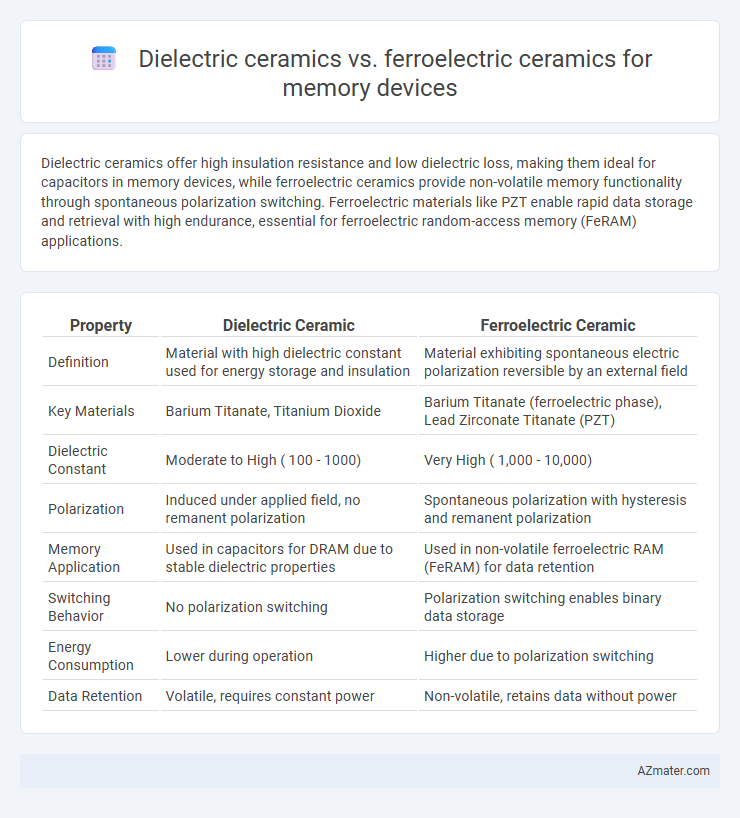Dielectric ceramics offer high insulation resistance and low dielectric loss, making them ideal for capacitors in memory devices, while ferroelectric ceramics provide non-volatile memory functionality through spontaneous polarization switching. Ferroelectric materials like PZT enable rapid data storage and retrieval with high endurance, essential for ferroelectric random-access memory (FeRAM) applications.
Table of Comparison
| Property | Dielectric Ceramic | Ferroelectric Ceramic |
|---|---|---|
| Definition | Material with high dielectric constant used for energy storage and insulation | Material exhibiting spontaneous electric polarization reversible by an external field |
| Key Materials | Barium Titanate, Titanium Dioxide | Barium Titanate (ferroelectric phase), Lead Zirconate Titanate (PZT) |
| Dielectric Constant | Moderate to High ( 100 - 1000) | Very High ( 1,000 - 10,000) |
| Polarization | Induced under applied field, no remanent polarization | Spontaneous polarization with hysteresis and remanent polarization |
| Memory Application | Used in capacitors for DRAM due to stable dielectric properties | Used in non-volatile ferroelectric RAM (FeRAM) for data retention |
| Switching Behavior | No polarization switching | Polarization switching enables binary data storage |
| Energy Consumption | Lower during operation | Higher due to polarization switching |
| Data Retention | Volatile, requires constant power | Non-volatile, retains data without power |
Introduction to Dielectric and Ferroelectric Ceramics
Dielectric ceramics exhibit high electrical insulation and polarization under an electric field, making them essential for capacitors and energy storage in memory devices. Ferroelectric ceramics possess spontaneous polarization that can be reversed by an external electric field, enabling non-volatile memory applications such as FeRAM. The fundamental difference lies in ferroelectric materials' switchable polarization states versus dielectric ceramics' linear polarization response, impacting device performance and data retention.
Fundamental Properties of Dielectric Ceramics
Dielectric ceramics used in memory devices possess high dielectric constant, low dielectric loss, and excellent electrical insulation, enabling efficient charge storage and minimal energy dissipation. Their fundamental properties include stable permittivity over a wide temperature range and resistance to electrical breakdown, which ensure reliable device performance. Unlike ferroelectric ceramics, dielectric ceramics lack spontaneous polarization but offer superior linear dielectric behavior essential for capacitive memory elements.
Unique Characteristics of Ferroelectric Ceramics
Ferroelectric ceramics possess spontaneous electric polarization that can be reversed by an external electric field, enabling non-volatile memory storage essential for ferroelectric random-access memory (FeRAM). Their key characteristics include high dielectric permittivity, fast switching speeds, and excellent endurance, which contribute to efficient data retention and low power consumption compared to dielectric ceramics. Unlike dielectric ceramics that exhibit linear polarization without hysteresis, ferroelectric ceramics show a distinctive hysteresis loop, making them uniquely suitable for memory devices requiring bistable states.
Material Composition and Microstructure Differences
Dielectric ceramics for memory devices typically consist of non-polar materials like barium titanate (BaTiO3) with a uniform, dense microstructure that enhances their insulating properties. Ferroelectric ceramics, such as lead zirconate titanate (PZT), contain polar crystal structures with spontaneous polarization and domain walls, enabling switchable electric dipoles essential for non-volatile memory. The microstructure of ferroelectric ceramics often features grain boundaries and domain configurations that influence their piezoelectric and ferroelectric responses, distinguishing them from the simpler, homogeneous dielectric ceramics.
Polarization Mechanisms in Memory Applications
Dielectric ceramics exhibit polarization through induced dipoles that align temporarily under an electric field, providing stability and low energy loss ideal for capacitive memory elements. Ferroelectric ceramics possess spontaneous polarization with switchable dipole orientations, enabling non-volatile memory storage via remanent polarization states. The reversible polarization in ferroelectric materials allows high-density data retention and fast switching speeds, making them superior for ferroelectric random-access memory (FeRAM) applications.
Capacitance and Data Storage Capabilities
Dielectric ceramics exhibit high permittivity and low dielectric loss, providing stable capacitance essential for capacitive memory devices, while ferroelectric ceramics possess spontaneous polarization that enables non-volatile data storage through polarization states. Ferroelectric materials deliver higher capacitance modulation under electric fields, allowing multi-bit storage capabilities and faster switching speeds compared to dielectric ceramics. The intrinsic remanent polarization in ferroelectric ceramics enhances their data retention without power, making them superior for ferroelectric random-access memory (FeRAM) applications.
Switching Behavior and Retention in Memory Devices
Dielectric ceramics exhibit stable switching behavior with low leakage currents, making them suitable for reliable capacitance-based memory devices but often suffer from limited retention times. Ferroelectric ceramics demonstrate robust, switchable polarization states enabling non-volatile memory applications with fast switching speeds and high endurance, while maintaining superior retention due to remnant polarization. The choice between dielectric and ferroelectric ceramics directly impacts memory device performance, balancing switching efficiency and data retention for specific storage requirements.
Energy Efficiency and Performance Comparison
Dielectric ceramics exhibit lower energy loss and higher insulation resistance, making them more energy-efficient for capacitive memory devices. Ferroelectric ceramics offer superior performance in non-volatile memory due to their spontaneous polarization and fast switching speeds, enabling higher data retention and endurance. However, ferroelectric materials generally consume more power during switching, balancing energy efficiency against enhanced memory device functionality.
Reliability and Longevity in Memory Device Integration
Dielectric ceramics exhibit superior reliability in memory devices due to their high insulation resistance and minimal dielectric loss, which reduce leakage currents and prevent data corruption over extended periods. Ferroelectric ceramics, characterized by their spontaneous polarization, enable non-volatile memory functions but may suffer from fatigue and imprint effects, potentially limiting device longevity. Optimizing ferroelectric memory integration involves balancing high remnant polarization with fatigue resistance to enhance both data retention and reliability during repeated read/write cycles.
Future Prospects of Ceramics in Next-Generation Memory Technologies
Dielectric ceramics exhibit high insulation properties ideal for capacitive storage, while ferroelectric ceramics offer non-volatile memory capabilities through reversible polarization states, making them pivotal in next-generation memory technologies. Advances in ferroelectric HfO2-based thin films promise enhanced scalability and endurance for future non-volatile memory devices like FeRAM and FeFETs. Integration of these ceramics in emerging neuromorphic and multilevel memory architectures highlights their critical role in achieving faster, low-power, and high-density data storage solutions.

Infographic: Dielectric ceramic vs Ferroelectric ceramic for Memory device
 azmater.com
azmater.com